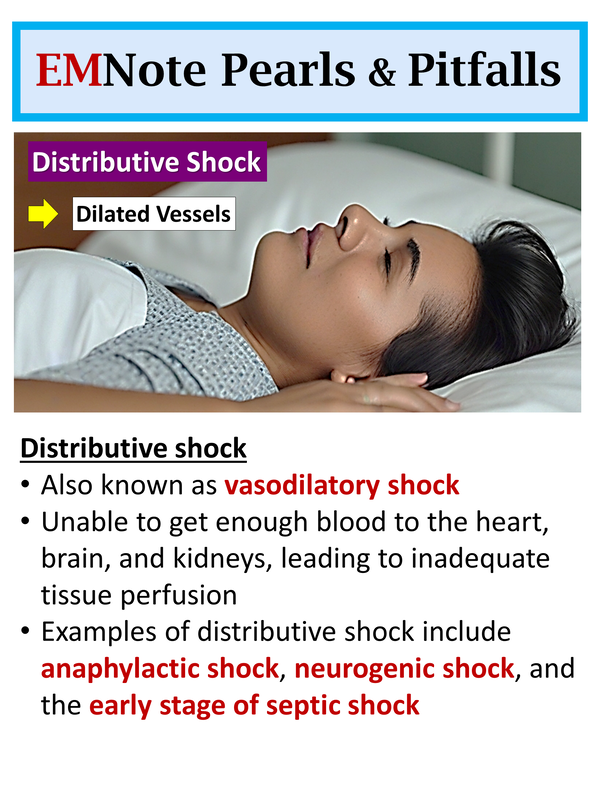|
5 Types of Shock:
Hypovolemic shock: Significant loss of blood and body fluids E.g., car accident resulting in massive internal bleeding Blood loss more than 20% blood volume Early signs: low BP, rapid HR, and pale, cool skin Immediate IV fluid replacement is a cornerstone of treatment Cardiogenic shock: Heart cannot pump enough blood to meet the body's needs Ex: severe myocardial infarction (heart attack) and severe heart failure Diagnosis: - ECG and cardiac biomarker levels Treatment: - Inotropic agents: dobutamine and epinephrine - Vasopressors: norepinephrine - Coronary angioplasty and stenting Distributive shock: Also known as vasodilatory shock Unable to get enough blood to the heart, brain, and kidneys, leading to inadequate tissue perfusion Examples of distributive shock include anaphylactic shock, neurogenic shock, and the early stage of septic shock. Anaphylactic shock: Life-threatening allergic reaction triggered by foods, insect stings, or medications Symptoms: hives, swelling, abdominal pain, and difficulty breathing, airway constriction (bronchospasm), angioedema, and severe hypotension The first-line treatment of anaphylactic shock is intramuscular epinephrine, 0.3-0.5 mg in adults; 0.01 mg/kg in children (max: 0.3 mg) Carry epinephrine auto-injector (EpiPen) Neurogenic Shock: Neurogenic shock occurs in patients with spinal cord injury above the T6 level Disruption in autonomic nervous system control results in widespread vasodilation, relative bradycardia, and hypotension Immobilize and stabilize the spine to prevent further damage Use IV fluids and vasopressors, such as dopamine and norepinephrine, to restore and maintain blood pressure and heart rate Septic shock: Systemic inflammatory response (SIRS) due to infection (usually bacteria) Vulnerable: infants, elderly, immunocompromised Early stage, known as warm or hyperdynamic shock, is a type of distributive shock, in which the pulse pressure is widened due to vasodilation Signs: fever, chills, hypothermia, confusion, hyperventilation, warm skin (early stage), clammy skin (late stage) Early broad-spectrum antibiotics Source control, surgery if indicated Monitor for signs of multi-organ dysfunction Obstructive shock: Reduction in blood flow due to obstruction within the circulatory system - within the heart, major blood vessels, or other structures that affect the heart's ability to pump blood Ex: pulmonary embolism, cardiac tamponade, tension pneumothorax, vena cava compression syndrome, and mediastinal tumors Tx: surgical drainage or pericardiocentesis to remove pericardial fluid or air, embolism removal with surgery or a catheter, or replacing a severely narrowed aortic valve
0 Comments
Leave a Reply. |

Author
|
Proudly powered by Weebly
